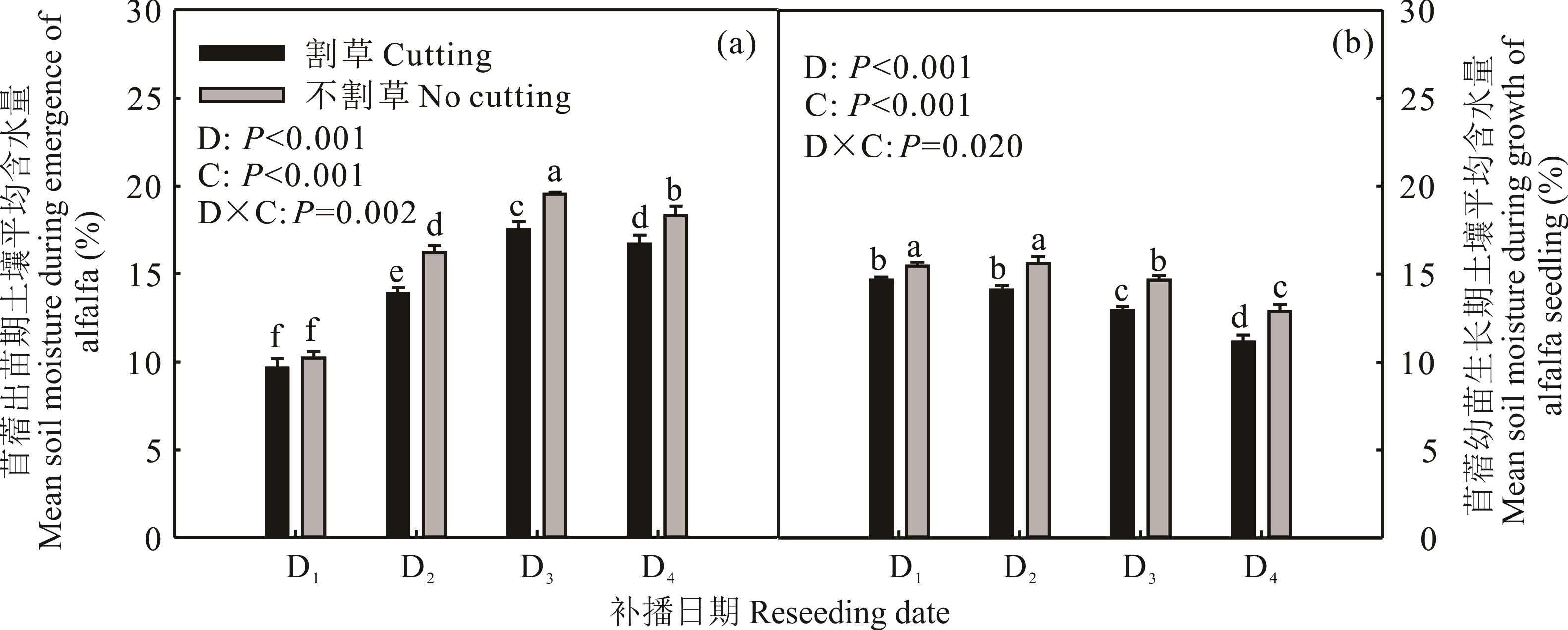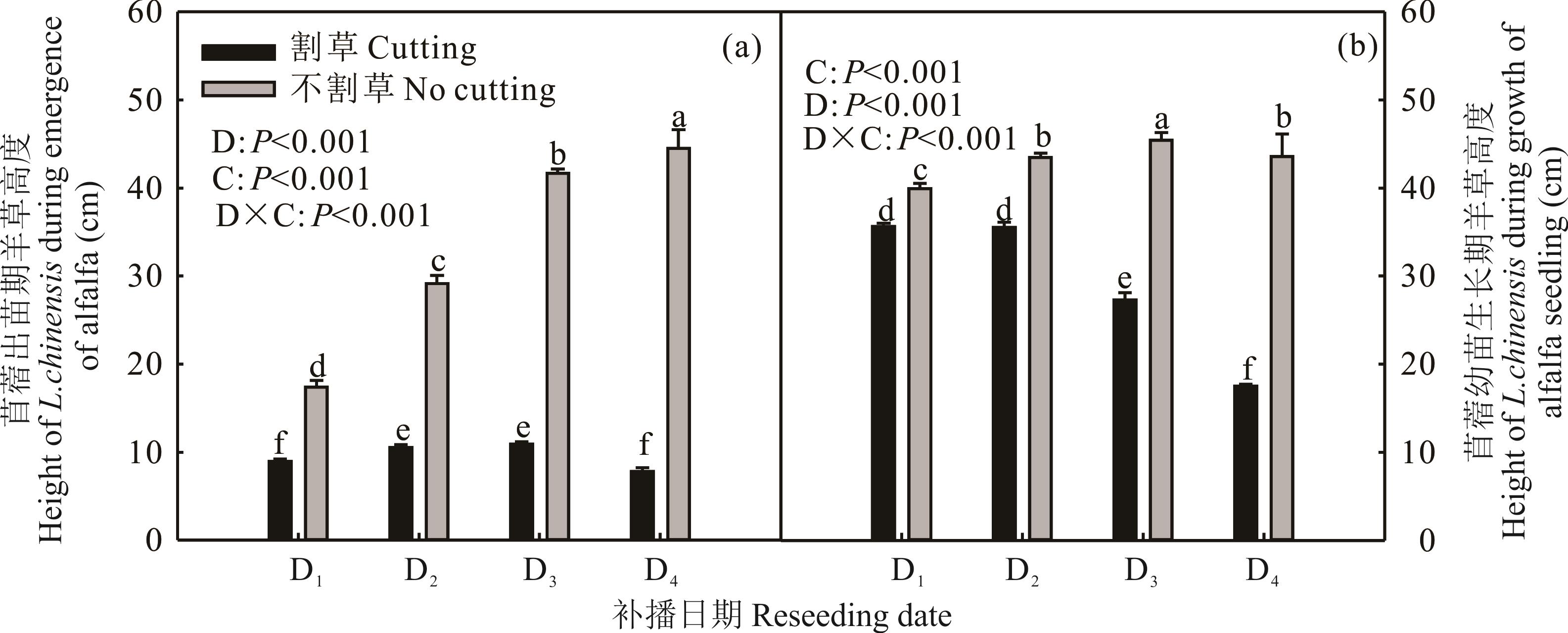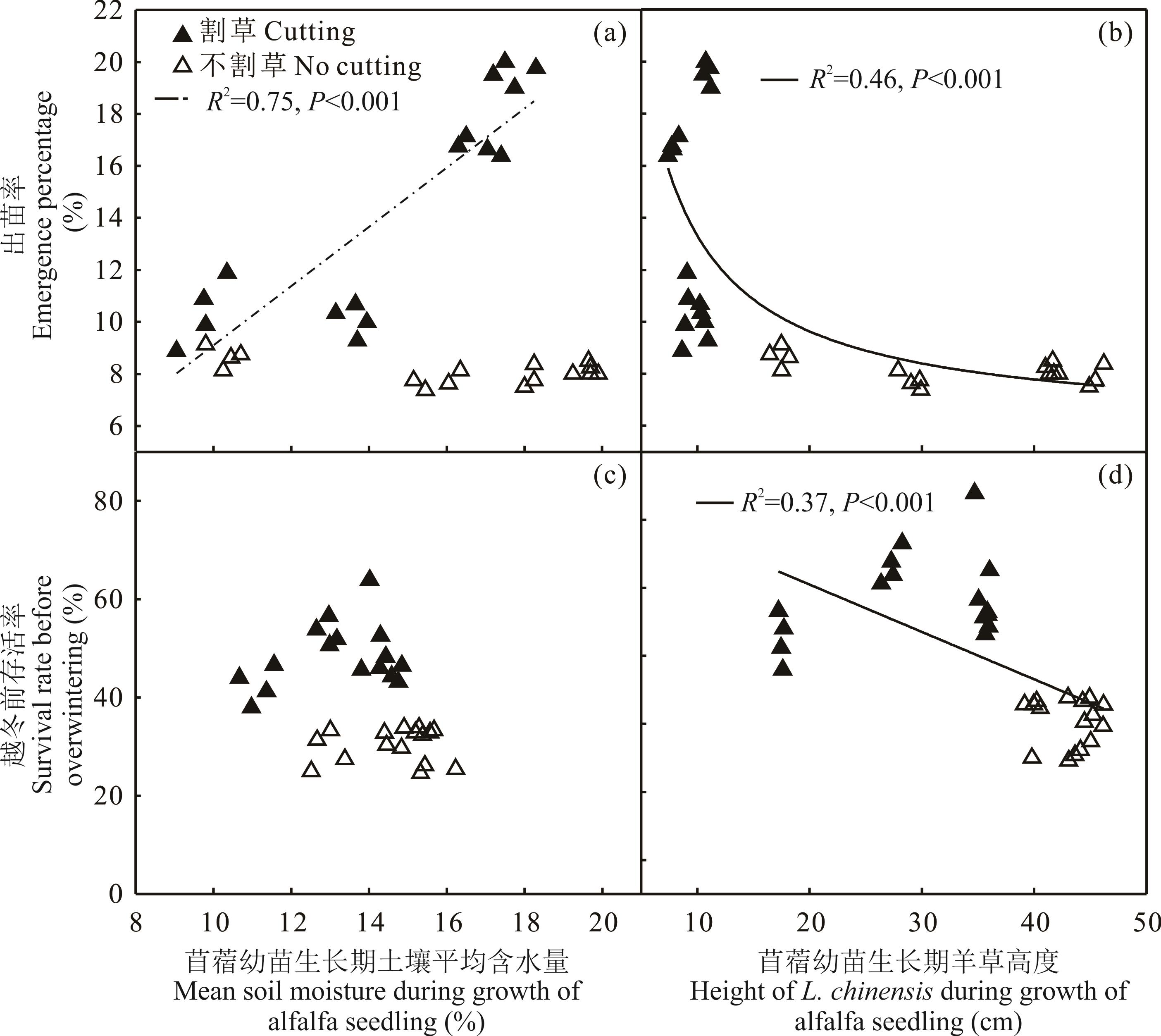

ISSN 1004-5759 CN 62-1105/S


草业学报 ›› 2022, Vol. 31 ›› Issue (11): 94-104.DOI: 10.11686/cyxb2021443
李强1,2( ), 丛山1,2,3, 赵成振1,2,3, 黄迎新1,2, 周道玮1,2
), 丛山1,2,3, 赵成振1,2,3, 黄迎新1,2, 周道玮1,2
收稿日期:2021-11-30
修回日期:2022-02-24
出版日期:2022-11-20
发布日期:2022-10-01
通讯作者:
李强
作者简介:李强(1984-),男,吉林农安人,副研究员,博士。E-mail: liqiang@iga.ac.cn基金资助:
Qiang LI1,2( ), Shan CONG1,2,3, Cheng-zhen ZHAO1,2,3, Ying-xin HUANG1,2, Dao-wei ZHOU1,2
), Shan CONG1,2,3, Cheng-zhen ZHAO1,2,3, Ying-xin HUANG1,2, Dao-wei ZHOU1,2
Received:2021-11-30
Revised:2022-02-24
Online:2022-11-20
Published:2022-10-01
Contact:
Qiang LI
摘要:
为揭示播期、播前刈割及其交互作用对补播紫花苜蓿建植的影响,选取轻度退化羊草草甸,在不同日期(5月1日、6月1日、7月1日、8月1日)和补播前2个刈割(刈割、不刈割)交互处理下进行紫花苜蓿补播,研究紫花苜蓿建植表现的变化及其生态学机制。结果发现:7月1日补播后苜蓿出苗期间土壤含水量最高,刈割降低了苜蓿出苗和幼苗生长期的羊草植被高度。播期和刈割对苜蓿建植的影响存在显著交互作用。刈割通过降低羊草植被高度显著提高苜蓿出苗率,刈割后,受土壤水分季节变化影响,7月1日补播的苜蓿出苗率(20%)显著高于其他播期。通过降低植被高度和地上资源竞争,割草显著提高苜蓿幼苗存活率,割草处理下,7月1日补播的苜蓿存活幼苗数及幼苗存活率最高,分别为83株·m-2和53%。随播期延后生长时间缩短,苜蓿幼苗发育受到限制,越冬率显著降低。割草通过促进幼苗生长显著提高了苜蓿幼苗越冬率。割草处理下,7月1日补播返青苜蓿植株数量达22株·m-2,显著高于其他播期。翌年群落调查数据表明:播前刈割显著提高了草地中紫花苜蓿生物量,且7月1日刈割后补播草地的苜蓿生物量显著高于其他处理,播前割草也显著提升了饲草粗蛋白含量。综合各处理紫花苜蓿补播效果和饲草生产实际,研究建议羊草草甸的紫花苜蓿补播应在植被刈割后进行,补播时间选择在7月1日前后对紫花苜蓿成功建植较为有利。
李强, 丛山, 赵成振, 黄迎新, 周道玮. 播期和播前刈割对羊草草甸中紫花苜蓿建植的影响[J]. 草业学报, 2022, 31(11): 94-104.
Qiang LI, Shan CONG, Cheng-zhen ZHAO, Ying-xin HUANG, Dao-wei ZHOU. The influences of reseeding date and mowing prior to reseeding on establishment of alfalfa in Leymus chinensis meadows[J]. Acta Prataculturae Sinica, 2022, 31(11): 94-104.

图2 不同播期和割草管理下苜蓿出苗期和幼苗生长期的土壤平均含水量D代表播期;D1: 5月1日; D2: 6月1日; D3: 7月1日; D4: 8月1日; C代表割草;D×C代表播期和割草交互作用;不同小写字母表示不同处理间差异显著。下同。D represents sowing date; D1: May 1; D2: June 1; D3: July 1; D4: August 1; C represents cutting; D×C represents the interaction effect between sowing date and cutting; Different lowercase letters indicated significant differences between different treatments. The same below.
Fig.2 Mean soil moisture during emergence and growth of alfalfa seedling under different sowing date and cutting managements

图3 不同播期和割草管理下苜蓿出苗期和幼苗生长期的羊草平均高度
Fig.3 Mean height of L. chinensis during emergence and growth of alfalfa seedling under different sowing date and cutting managements

图5 不同播期和割草管理下紫花苜蓿幼苗地上生物量、根生物量、根系可溶性糖含量及根系氮含量
Fig.5 Aboveground biomass, root biomass and root soluble sugar and nitrogen concentrations of M. sativa seedling under different sowing date and cutting managements

图6 苜蓿出苗率、存活率与土壤含水量、羊草高度的关系-·表示割草处理数据的回归线, -表示全部数据的回归线,下同。 -· shows regression line under cutting treatment, - shows regression line with all data. The same below.
Fig.6 Correlation between emergence rate, survival rate and soil water content and height of L. chinensis

图7 苜蓿越冬率与越冬前苜蓿根生物量及根可溶性糖含量的关系……表示不割草处理数据的回归线。…… shows regression line under no cutting treatment.
Fig.7 Correlation between overwintering rate of M. sativa and its root biomass and root soluble sugar concentration

图8 苜蓿补播次年不同播期和割草管理下草地紫花苜蓿地上生物量、总地上生物量及饲草粗蛋白含量
Fig.8 M. Sativa aboveground biomass, total aboveground biomass and crude protein concentration of forage in second year after reseeding under different sowing date and cutting managements
| 1 | Zhu T C, Yang D C, Jing D W, et al. Monitoring of dynamic yield of Aneurolepidium chinense in Northeast China. Scientia Agriculture Sinica, 1964, 3: 49-50. |
| 祝廷成, 杨殿臣, 景鼎武, 等. 东北羊草草原产草量动态的观测. 中国农业科学, 1964, 3: 49-50. | |
| 2 | Na J, Huang L H, Zhang L, et al. The current situation of grassland productivity and strategy for sustainable development in Northeast Grassland of China. Chinese Journal of Grassland, 2019, 41: 152-164. |
| 那佳, 黄立华, 张璐, 等. 我国东北草地生产力现状及可持续发展对策. 中国草地学报, 2019, 41: 152-164. | |
| 3 | Li Q, Zhou D W. Soil respiration versus vegetation degradation under the influence of three grazing regimes in the Songnen Plain. Land Degradation and Development, 2018, 29: 2403-2416. |
| 4 | Mortenson M C, Schuman G E, Ingram L J, et al. Forage production and quality of a mixed-grass rangeland interseeded with Medicago sativa ssp. falcata. Rangeland Ecology and Management, 2005, 58(5): 505-513. |
| 5 | Phelan P, Moloney A P, McGeough E J, et al. Forage legumes for grazing and conserving in ruminant production systems. Critical Reviews in Plant Science, 2015, 34: 281-326. |
| 6 | Zhou J Q, Zhang F G, Huo Y Q, et al. Following legume establishment, microbial and chemical associations facilitate improved productivity in degraded grasslands. Plant and Soil, 2019, 443: 273-292. |
| 7 | Li Q, Yu P J, Li G D, et al. Grass-legume ratio can change soil carbon and nitrogen storage in a temperate steppe grassland. Soil and Tillage Research, 2016, 157: 23-31. |
| 8 | Van Ruijven J, Berendse F. Diversity-productivity relation-ships: Initial effects, long-term patterns, and underlying mechanisms. PNAS, 2005, 102(3): 695-700. |
| 9 | Li Q, Song Y T, Li G D, et al. Grass-legume mixtures impact soil N, species recruitment, and productivity in temperate steppe grassland. Plant and Soil, 2015, 349(1): 271-285. |
| 10 | Li Q, Zhou D W, Song Y T. The distribution feature of two widespread legumes and their relationships with soil factors in Songnen grassland. Acta Prataculturae Sinica, 2014, 23(1): 31-40. |
| 李强, 周道玮, 宋彦涛. 松嫩草地两种广布豆科植物分布特征及其与土壤因子关系. 草业学报, 2014, 23(1): 31-40. | |
| 11 | Zhang G X, Deng W, He Y, et al. Hydrochemical characteristics and evolution laws of groundwater in Songnen Plain, Northeast China. Advances in Water Science, 2006, 17(1): 20-28. |
| 章光新, 邓伟, 何岩, 等. 中国东北松嫩平原地下水水化学特征与演变规律. 水科学进展, 2006, 17(1): 20-28. | |
| 12 | Zhou D W, Zhang Z X, Jin Y H, et al. Regionalization and distribution pattern of vegetation of Northeast China. Chinese Journal of Plant Ecology, 2010, 34(12): 1359-1368. |
| 周道玮, 张正祥, 靳英华, 等. 东北植被区划及其分布格局. 植物生态学报, 2010, 34(12): 1359-1368. | |
| 13 | Wang Y Z, Xu B, Xu A K, et al. Effect of sowing date on forage yield, growth and overwintering rate of alfalfa. Chinese Agricultural Science Bulletin, 2015, 31(8): 16-20. |
| 王英哲, 徐博, 徐安凯, 等. 播期对紫花苜蓿草产量, 生长发育及越冬率的影响. 中国农学通报, 2015, 31(8): 16-20. | |
| 14 | Li Q, Zhou D W, Zhang H. Response of overwintering performance of 9 legumes forages to a late sowing date. Pratacultural Science, 2018, 35(8): 1899-1909. |
| 李强, 周道玮, 张慧. 9 种豆科饲草越冬性能对晚播期的响应. 草业科学, 2018, 35(8): 1899-1909. | |
| 15 | Zhou J Q, Zhang Y J, Wilson G W T, et al. Small vegetation gaps increase reseeded yellow-flowered alfalfa performance and production in native grasslands. Basic and Applied Ecology, 2017, 24: 41-52. |
| 16 | Bagavathiannan M V, Gulden R H, Van Acker R C. The ability of alfalfa (Medicago sativa) to establish in a seminatural habitat under different seed dispersal times and disturbance. Weed Science, 2011, 59(3): 314-320. |
| 17 | Kunelius H T, Campbell A J, Ivany J A, et al. Effects of vegetation suppression and drilling techniques on the establishment and growth of sod-seeded alfalfa and bird’s-foot trefoil in grass dominant swards. Canadian Journal of Plant Science, 1982, 62(3): 667-675. |
| 18 | Seguin P, Peterson P R, Sheaffer C C, et al. Physical sod suppression as an alternative to herbicide use in pasture renovation with clovers. Canadian Journal of Plant Science, 2001, 81(2): 255-263. |
| 19 | Jennings J A, Coblentz W K, Cassida K A. Planting date and bermudagrass stubble height effects on establishment of alfalfa in bermudagrass sod. American Forage and Grassland Council, 2002, 11: 237-241. |
| 20 | Li H S. Principle and technology of plant physiological and biochemical experiments. Beijing: Higher Education Press, 2000. |
| 李合生. 植物生理生化实验原理和技术. 北京: 高等教育出版社, 2000. | |
| 21 | Bao S D. Soil and agricultural chemistry analysis. Beijing: China Agriculture Press, 2000. |
| 鲍士旦. 土壤农化分析. 北京: 中国农业出版社, 2000. | |
| 22 | Yan Z M, Chen Q, Zhang Y J, et al. Study on early establishment of reseeding forage legumes into natural mowing grassland in Bashang of Hebei province. Acta Agrestia Sinica, 2016, 24(1): 178-183. |
| 阎子盟, 陈倩, 张玉娟, 等. 河北坝上天然割草地补播豆科牧草早期建植的研究. 草地学报, 2016, 24(1): 178-183. | |
| 23 | Li Y, Qi W W, Li S Y, et al. Seed germination and seedling growth of Medicago sativa in response to the variations of temperature, light, and burial depth. Chinese Journal of Ecology, 2021, 40: 231-239. |
| 李阳, 亓雯雯, 李绍阳, 等. 苜蓿种子萌发和幼苗生长对温度、光照和埋深的响应. 生态学杂志, 2021, 40: 231-239. | |
| 24 | Zhao M, Zhang H X, Yan H, et al. Effects of light intensity on seed germination and seedling growth of six species in grassland. Ecological Science, 2018, 37: 25-34. |
| 赵明, 张红香, 颜宏, 等. 光照强度对六种草地植物种子萌发和幼苗生长的影响. 生态科学, 2018, 37: 25-34. | |
| 25 | Donath T W, Eckstein R L. Grass and oak litter exert different effects on seedling emergence of herbaceous perennials from grasslands and woodlands. Journal of Ecology, 2008, 96(2): 272-280. |
| 26 | Li Y K, Du Y G, Zhang Z Z, et al. Research progresses on seed reseeding to recover the degraded grassland. Acta Agrestia Sinica, 2017, 25(6): 1171-1177. |
| 李以康, 杜岩功, 张正芝, 等. 种子补播恢复退化草地研究进展. 草地学报, 2017, 25(6): 1171-1177. | |
| 27 | Cui G W. The physiological responses of cold resistance in alfalfa during overwintering period in the field. Acta Agrestia Sinica, 2009, 17(2): 145-150. |
| 崔国文. 紫花苜蓿田间越冬期抗寒生理研究. 草地学报, 2009, 17(2): 145-150. | |
| 28 | Zhu A M, Han G D, Zhang Y X, et al. Influence and analysis of different sowing time on overwintering rate of alfalfa. Acta Agrestia Sinica, 2020, 28(2): 446-453. |
| 朱爱民, 韩国栋, 张玉霞, 等. 不同播种时期对紫花苜蓿越冬率影响及分析. 草地学报, 2020, 28(2): 446-453. | |
| 29 | Zhang Y X, Wang X G, Tian Y L, et al. Effect of sowing date on cold resistance of different alfalfa varieties in Horqin sandy land. Acta Prataculturae Sinica, 2020, 29(4): 73-80. |
| 张玉霞, 王显国, 田永雷, 等. 科尔沁沙地播种时期对不同紫花苜蓿品种抗寒性的影响. 草业学报, 2020, 29(4): 73-80. |
| [1] | 王晓龙, 杨曌, 来永才, 李红, 钟鹏, 徐艳霞, 柴华, 李莎莎, 吴玥, 宋敏超, 周景明. 不同秋眠等级苜蓿根系性状对越冬的影响[J]. 草业学报, 2023, 32(1): 144-153. |
| [2] | 李惟婕, 王立, 马景永, 王自奎. 黄土旱塬区苹果园生草覆盖对深层土壤水分和根系分布特征的影响[J]. 草业学报, 2023, 32(1): 63-74. |
| [3] | 孙延亮, 赵俊威, 刘选帅, 李生仪, 马春晖, 王旭哲, 张前兵. 施氮对苜蓿初花期光合日变化、叶片形态及干物质产量的影响[J]. 草业学报, 2022, 31(9): 63-75. |
| [4] | 王星, 黄薇, 余淑艳, 李小云, 高雪芹, 伏兵哲. 宁夏地区地下滴灌水肥耦合对紫花苜蓿种子产量及构成因素的影响[J]. 草业学报, 2022, 31(9): 76-85. |
| [5] | 赵建涛, 岳亚飞, 张前兵, 马春晖. 不同秋眠级紫花苜蓿品种抗寒性对新疆北疆地区覆雪厚度的响应[J]. 草业学报, 2022, 31(8): 24-34. |
| [6] | 刘彩婷, 毛丽萍, 阿依谢木, 于应文, 沈禹颖. 紫花苜蓿与垂穗披碱草混播比例对其抗寒生长生理特征的影响[J]. 草业学报, 2022, 31(7): 133-143. |
| [7] | 王雪萌, 何欣, 张涵, 宋瑞, 毛培胜, 贾善刚. 基于多光谱成像技术快速无损检测紫花苜蓿人工老化种子[J]. 草业学报, 2022, 31(7): 197-208. |
| [8] | 李满有, 李东宁, 王斌, 李小云, 沈笑天, 曹立娟, 倪旺, 王腾飞, 兰剑. 不同苜蓿品种混播和播种量对牧草产量及品质的影响[J]. 草业学报, 2022, 31(5): 61-75. |
| [9] | 孙洪仁, 王显国, 卜耀军, 乔楠, 任波. 黄土高原紫花苜蓿土壤氮素丰缺指标和推荐施氮量初步研究[J]. 草业学报, 2022, 31(4): 32-42. |
| [10] | 高丽敏, 陈春, 沈益新. 氮磷肥对季节性栽培紫花苜蓿生长及再生的影响[J]. 草业学报, 2022, 31(4): 43-52. |
| [11] | 欧成明, 赵美琦, 孙铭, 毛培胜. 抗坏血酸和水杨酸丸衣对NaCl胁迫下紫花苜蓿种子发芽特性的影响[J]. 草业学报, 2022, 31(4): 93-101. |
| [12] | 童长春, 刘晓静, 吴勇, 赵雅姣, 王静. 内源异黄酮对紫花苜蓿结瘤固氮及氮效率的调控研究[J]. 草业学报, 2022, 31(3): 124-135. |
| [13] | 刘启宇, 云岚, 陈逸凡, 郭宏宇, 李珍, 高志琦, 王俊, 石凤翎. 苜蓿—禾草混播草地牧草产量及种间竞争关系的动态研究[J]. 草业学报, 2022, 31(3): 181-191. |
| [14] | 张岳阳, 李芳, 梁维维, 李彦忠. 新疆昌吉32个紫花苜蓿品种的田间抗病性评价[J]. 草业学报, 2022, 31(2): 133-146. |
| [15] | 王斌, 杨雨琦, 李满有, 倪旺, 海艺蕊, 张顺香, 董秀, 兰剑. 不同播种量下行距配置对紫花苜蓿产量及品质的影响[J]. 草业学报, 2022, 31(2): 147-158. |
| 阅读次数 | ||||||
|
全文 |
|
|||||
|
摘要 |
|
|||||